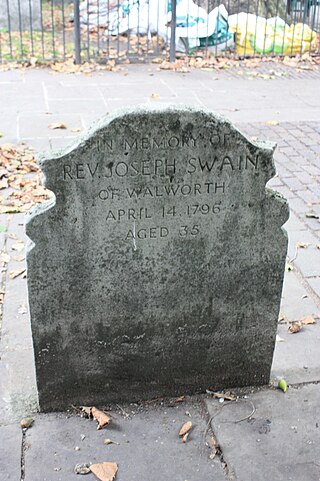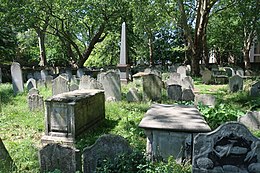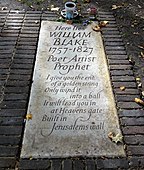
Kensal Green Cemetery is a cemetery in the Kensal Green area of North Kensington in the Royal Borough of Kensington and Chelsea and the London Borough of Hammersmith and Fulham in London, England. Inspired by Père Lachaise Cemetery in Paris, it was founded by the barrister George Frederick Carden. The cemetery opened in 1833 and comprises 72 acres (29 ha) of grounds, including two conservation areas, adjoining a canal. The cemetery is home to at least 33 species of bird and other wildlife. This distinctive cemetery has memorials ranging from large mausoleums housing the rich and famous to many distinctive smaller graves and includes special areas dedicated to the very young. It has three chapels and serves all faiths. It is one of the Magnificent Seven cemeteries in London.

Samuel Chandler was an English Nonconformist minister and pamphleteer. He has been called the "uncrowned patriarch of Dissent" in the latter part of George II's reign.

Abney Park cemetery is one of the "Magnificent Seven" cemeteries in London, England.
Theophilus Gale (1628–1678) was an English educationalist, nonconformist and theologian of dissent.

Theophilus Lindsey was an English theologian and clergyman who founded the first avowedly Unitarian congregation in the country, at Essex Street Chapel. Lindsey's 1774 revised prayer book based on Samuel Clarke's alterations to the 1662 Book of Common Prayer inspired over a dozen similar revisions in the succeeding decades, including the prayer book still used by the United States' first Unitarian congregation at King's Chapel, Boston.

The London Borough of Islington is short of large parks and open spaces, given its status in recent decades as a desirable place of residence. In fact, Islington has the lowest ratio of open space to built-up areas of any London borough. The largest continuous open space in the borough, at 11.75 hectares, is Highbury Fields.

Sir Charles Reed FSA was a British politician who served as Member of Parliament for Hackney and for St Ives, Chairman of the London School Board, Director and Trustee of the original Abney Park Cemetery Joint Stock Company, Chairman of the Bunhill Fields Preservation Committee, associate of George Peabody, lay Congregationalist, and owner of a successful commercial type-founding business in London. He was elected a Fellow of the Society of Antiquaries, and was knighted by the Queen at Windsor Castle in 1874. As a pastime he collected autographed letters and keys.

King's Chapel Burying Ground is a historic graveyard on Tremont Street, near its intersection with School Street, in Boston, Massachusetts. Established in 1630, it is the oldest graveyard in the city and is a site on the Freedom Trail. Despite its name, the graveyard pre-dates the adjacent King's Chapel ; it is not affiliated with that or any other church.

Daniel Williams was a British benefactor, minister and theologian, within the Presbyterian tradition, i.e. a Christian outside the Church of England. He is known largely for the legacy he left which led to the creation of Dr Williams's Library, a centre for research on English Dissenters.

Eden Cemetery is a historic African-American cemetery located in Collingdale, Pennsylvania. It was established June 20, 1902, and is the oldest existing black owned cemetery in the United States. The cemetery covers about 53 acres and contains approximately 93,000 burials.
Daniel Dyke (1617–1688) was an English Baptist minister.
The dissenting academies were schools, colleges and seminaries run by English Dissenters, that is, Protestants who did not conform to the Church of England. They formed a significant part of education in England from the mid-seventeenth to nineteenth centuries.
Thomas Rowe (1657–1705) was an English nonconformist minister, significant as the teacher of the next generation of Dissenters, particularly in philosophy, in one of the first of the dissenting academies.

Reading Old Cemetery is situated in the eastern part of Reading, Berkshire, England. It is located immediately to the east of Cemetery Junction, a major road junction in Reading. The cemetery is Grade II listed.
Joshua Oldfield, was an English presbyterian divine.

Reverend Samuel Rosewell was a Presbyterian minister born at Rotherhithe, Surrey.

Joseph Swain was a British Baptist minister, poet and hymnwriter. Born in Birmingham, and orphaned at an early age, he was apprenticed as an engraver in Birmingham and afterwards in London. He experienced a religious conversion in 1782, and was baptised by John Rippon in the Baptist meeting-house in Carter Lane, Tooley Street, Southwark, on 11 May 1783. He subsequently became a Baptist minister and pastor of East Street Baptist church in Walworth from 1792 until his death in 1796. He was a popular preacher, and during the period of his ministry it became necessary to extend the church building on three occasions.

The Congregationalist Cemetery at Ponsharden, Cornwall was opened in 1808 to serve the Dissenting Christian congregations of Falmouth and Penryn. It received approximately 587 burials over a period of 120 years, before being abandoned in the 1930s. During the 20th century the site experienced significant neglect and extensive vandalism. In May 2012 a volunteer group began to restore the burial ground which is now a protected Scheduled Monument of national importance. The place-name Ponsharden is recorded in 1677 as "Ponshardy"; its meaning is Hardy's bridge.

Quaker Gardens is a small public garden in the extreme south of the London Borough of Islington, close to the boundary with the City of London, in the area known historically as Bunhill Fields. It is managed by Islington Borough Council. It comprises the surviving fragment of a former burying ground for Quakers, in use from 1661 to 1855. George Fox, one of the founders of the movement, was among those buried here.

Beckett Street Cemetery is a closed cemetery in Burmantofts, Leeds, West Yorkshire, England. Founded in 1842, the site was officially opened in 1845 and is recognised as being one of England's first municipal burial sites. Although the cemetery was closed to interments in 2001, it remains open for visitors, and has two listed structures besides being a listed park itself.



![Monument of Dame Mary Page (died 1729). The inscription reads in part: "In 67 months she was tap'd [tapped] 66 times, Had taken away 240 gallons of water without ever repining at her case or ever fearing the operation." Mary Page monument 2.JPG](http://upload.wikimedia.org/wikipedia/commons/thumb/b/b0/Mary_Page_monument_2.JPG/220px-Mary_Page_monument_2.JPG)






































